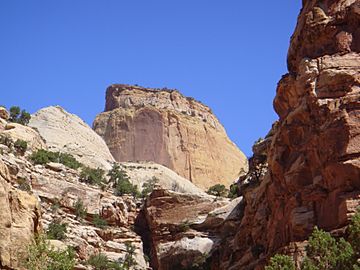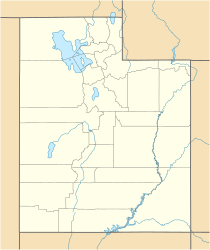Golden Throne (mountain) facts for kids
Quick facts for kids Golden Throne |
|
|---|---|

The Golden Throne from Capitol Gorge
|
|
| Highest point | |
| Elevation | 7,042 ft (2,146 m) NGVD 29 |
| Prominence | 462 ft (141 m) |
| Geography | |
| Location | Wayne County, Utah U.S. |
| Topo map | USGS Golden Throne |
| Climbing | |
| Easiest route | Strenuous hike |
The Golden Throne is a unique mountain in Capitol Reef National Park in Wayne County, Utah, United States. It stands out because of its amazing golden color. This mountain is a special type of rock formation called a dome.
It's named "Golden Throne" because its rocks glow with a beautiful gold color, especially when the sun shines on them. This makes it look like a giant, royal seat in the desert.
Contents
The Golden Color Mystery
Most of the rocks in this area are usually creamy white or red. So, why is the Golden Throne different? Its special color comes from the type of rock it's made of.
The Golden Throne is mostly made of a rock called Navajo Sandstone. Normally, this sandstone is a light color. However, a small amount of another rock layer, called the Carmel Formation, sits on top of the Navajo Sandstone here.
Over a very long time, tiny bits of minerals from the Carmel Formation have washed down. These minerals stained the Navajo Sandstone below, giving it its unique golden hue. It's like nature's own paint job!
Exploring the Golden Throne Area
The Golden Throne is about 7,042 feet (2,146 m) tall. It is part of a much larger geological feature called the Waterpocket Fold. This fold is like a giant wrinkle in the Earth's crust. It stretches for nearly 100 miles (160 km) through Capitol Reef National Park.
Trails and Views
You can enjoy the beauty of the Golden Throne from a trail that runs below it. This trail is about 2 miles (3.2 km) long. It offers amazing views of the mountain and the surrounding desert landscape. Hiking here lets you see the unique golden rocks up close.
The area around the Golden Throne is perfect for exploring. It shows off the incredible natural forces that have shaped Utah's landscapes over millions of years.


